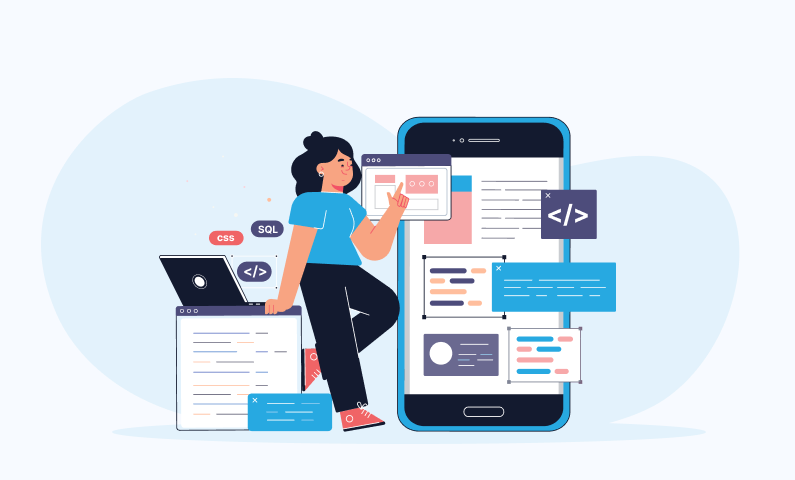In today’s fast-paced digital landscape, businesses must innovate and deploy new software solutions rapidly to remain competitive. Traditional software development is slow, expensive, and resource-intensive, requiring teams of skilled developers to write and maintain complex code. Low-code platforms have emerged as a game-changer, enabling businesses to develop robust applications with minimal hand-coding.
By offering drag-and-drop interfaces, pre-built components, and visual workflows, low-code platforms significantly reduce development time and costs while allowing both technical and non-technical users to participate in application creation.
This blog explores the concept of low-code platforms, their key benefits, real-world use cases, top platforms, challenges, and the future of low-code application development.
What are Low-Code Platforms?
Low-code platforms are development environments in which the creation of applications involves little or less coding. Instead, low-code platforms make software development more accessible and easier, providing a visual approach that depends on pre-configured templates, drag-and-drop tools, and automated workflows that help accelerate the process.
How Do Low-Code Platforms Work?
Visual Development: The designing of applications uses graphical user interfaces rather than producing lengthy lines of code.
- Pre-Built Modules:
Common functionalities such as authentication, payment gateways, and APIs are available as pre-built components.
- Workflow Automation:
Automated processes reduce manual effort in app logic, approvals, and data management.
- Integration Capabilities:
Seamless integration with third-party services, databases, and legacy systems allows businesses to modernize their operations without overhauling existing infrastructure.
Low-Code vs. No-Code: What’s the Difference?
Low-Code Platforms:
Require minimal coding, making them suitable for both developers and non-developers. Some technical expertise is beneficial for customizations.
No-Code Platforms:
Completely eliminate coding, allowing business users with no programming experience to build applications using visual interfaces.
Key Benefits of Low-Code Platforms
1. Faster Development Cycles
Low-code platforms drastically reduce development time by offering ready-made components and automation tools. Businesses can quickly prototype, iterate, and deploy applications, reducing time-to-market.
Example:
In weeks rather than in months, a healthcare provider can build a patient management system. This means that appointment scheduling and patient records are streamlined.
2. Cost-Efficiency
Low-code platforms thus reduce the size of large development teams because the need for them is reduced. More resources are, therefore, re-allocated for innovation rather than coding.
Example:
A retail company develops an app that tracks inventories without hiring a full stack development team, saving it money in development costs.
3. Citizen Developers
Citizen developers are empowered by low-code platforms.
Low-code platforms empower citizen developers in a business setting, allowing nontechnical business users to participate in developing applications, hence reducing dependency on IT departments and accelerating innovation.
Example:
Marketing team develops an automated campaign tracking tool without needing any intervention from the IT department, thus streamlining lead management.
4. Easy Integration with Legacy Systems
Low-code platforms enable easy integration with CRMs, ERPs, payment gateways, and cloud services for modern businesses relying on multiple software solutions.
Example:
A financial services company connects its proprietary client portal to an existing banking system to ensure that the data is always in real-time.
5. Scalability and Flexibility
Low-code applications can be scaled easily as the business grows. Developers can add new features, support more users, and optimize performance without significant disruptions.
Example:
A logistics company scales its fleet management application to accommodate international shipping, thereby expanding its reach.
6. Better Collaboration Between IT and Business Teams
Low-code development promotes collaboration between technical and non-technical teams, ensuring that applications are in line with business objectives.
Example:
A human resources department collaborates with developers to create a custom employee onboarding system.
7. Better Security and Compliance
Many low-code platforms have security features such as role-based access, data encryption, and compliance with industry regulations.
Example:
A fintech company uses a low-code platform with GDPR-compliant data handling to build a secure customer authentication system.
8. AI and Machine Learning Capabilities
Advanced low-code platforms include AI and machine learning features. Businesses can use them to integrate predictive analytics, chatbots, and intelligent automation into their services.
Example:
An e-commerce company uses a low-code platform to implement an AI-driven recommendation engine to personalize shopping experiences for customers.
Top Use Cases of Low-Code Platforms:
1. Business Process Automation
Low-code platforms automate routine processes such as invoice generation, approvals, and employee management, reducing manual effort and increasing efficiency.
Example:
A law firm automates contract management and approval workflows, reducing paperwork and improving compliance.
2. Customer Relationship Management (CRM)
Organizations can build custom CRM applications that cater to their needs, enhancing customer engagement and sales tracking.
Example:
A travel agency builds a CRM to track customer bookings, preferences, and interactions, enhancing personalized service.
3. Mobile and Web Application Development
A business can build mobile and web applications in minimal coding, and hence, makes digital transformation a more feasible exercise.
Example:
A restaurant chain develops a food delivery application with the help of a low-code platform that supports online ordering and loyalty rewards.
4. Data Analytics and Dashboards
The low-code development platform helps companies create interactive dashboards, thereby enabling real-time analysis of performance metrics.
Example:
A manufacturer creates a dashboard for monitoring production to help the factory improve efficiency and reduce downtime.
5. E-Commerce Solutions
Retail enterprises can create bespoke e-commerce platforms with payment integration and inventory tracking and personalized recommendations.
Example:
A boutique fashion brand will develop a virtual store with AI-powered product recommendations and automated order fulfillment.
6. HR and Employee Management Systems
Organizations can digitize employee management -leave tracking, performance reviews, and payroll processing.
Example:
A multination company launches a self-service HR portal that helps in faster processing of requests and submission of documents.
7. IT Service Management (ITSM)
Low-code platforms can be used for developing solutions such as helpdesk support, tracking incidents, and asset management.
Example:
An IT ticketing system is built by a software company to enable efficient technical support requests.
Well-known Low-code Platforms:
1. OutSystems
It is one of the leading enterprise-level low-code platforms, which emphasizes scalability and artificial intelligence-based development.
2. Mendix
Mendix is a collaboration-centric platform that’s business and IT aligned, which is suitable for web and mobile applications.
3. Microsoft PowerApps
The platform seamlessly integrates with the Microsoft ecosystem and helps businesses create apps connected to SharePoint, Dynamics 365, and Office 365.
4. Appian
It’s used in finance and healthcare to automate business processes and workflow management.
5. Salesforce Lightning
The platform is suited for CRM-related applications and enables businesses to improve their Salesforce ecosystem with custom apps.
Challenges and Considerations:
1. Customization Limitations
Whereas low-code platforms speed up development, very complex applications need traditional coding for total customization.
2. Security and Compliance Risks
Business organizations dealing with sensitive information should have low-code technologies ensure compliance with regulations, such as GDPR and HIPAA.
3. Vendor Lock-In
Companies should determine the flexibility of low-code technologies so as to not get locked into one vendor’s ecosystem.
4. Performance Optimization
Scaling to several thousand users may require performance optimization for stability and responsiveness.
The Future of Low-Code Platforms
Low-code development is changing rapidly, with the advancements in AI, automation, and cloud computing enhancing its capabilities. As businesses continue to embrace digital transformation, low-code platforms will play a pivotal role in:
- Accelerating software innovation
- Bridging the IT skills gap
- Enhancing business agility
- Driving cost-effective digital transformation
Final Thoughts
With low-code platforms, organizations can build applications much faster, making them cost-effective and efficient. The possibilities range from workflow automation to the creation of customer-facing applications. Businesses employing these platforms will be significantly more competitive in an increasingly digital world as the adoption of low-code continues to grow.
If you are looking to get started with low code platforms, we are here to help you with it. You can get in touch with us.

Start a Project with Ajackus

























